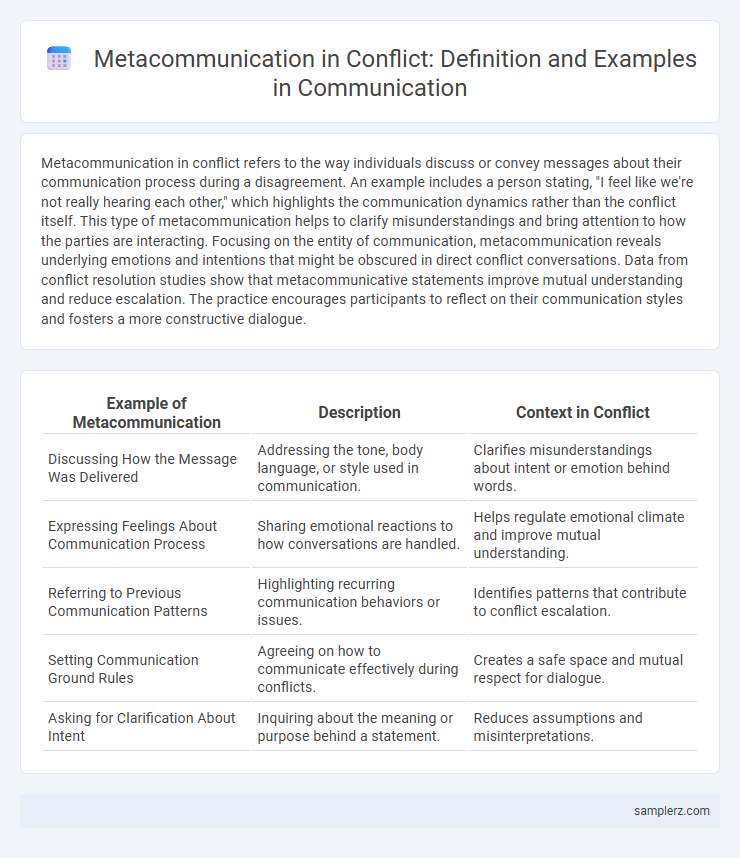Metacommunication in conflict refers to the way individuals discuss or convey messages about their communication process during a disagreement. An example includes a person stating, "I feel like we're not really hearing each other," which highlights the communication dynamics rather than the conflict itself. This type of metacommunication helps to clarify misunderstandings and bring attention to how the parties are interacting. Focusing on the entity of communication, metacommunication reveals underlying emotions and intentions that might be obscured in direct conflict conversations. Data from conflict resolution studies show that metacommunicative statements improve mutual understanding and reduce escalation. The practice encourages participants to reflect on their communication styles and fosters a more constructive dialogue.
Table of Comparison
| Example of Metacommunication | Description | Context in Conflict |
|---|---|---|
| Discussing How the Message Was Delivered | Addressing the tone, body language, or style used in communication. | Clarifies misunderstandings about intent or emotion behind words. |
| Expressing Feelings About Communication Process | Sharing emotional reactions to how conversations are handled. | Helps regulate emotional climate and improve mutual understanding. |
| Referring to Previous Communication Patterns | Highlighting recurring communication behaviors or issues. | Identifies patterns that contribute to conflict escalation. |
| Setting Communication Ground Rules | Agreeing on how to communicate effectively during conflicts. | Creates a safe space and mutual respect for dialogue. |
| Asking for Clarification About Intent | Inquiring about the meaning or purpose behind a statement. | Reduces assumptions and misinterpretations. |
Defining Metacommunication in Conflict
Metacommunication in conflict refers to the process of communicating about the communication itself, clarifying intentions, emotions, and interpretations to prevent misunderstandings. It involves openly discussing how messages are conveyed and received, which helps to identify underlying issues beyond the explicit content of the conflict. Effective metacommunication can de-escalate tension by fostering mutual understanding and promoting constructive dialogue.
The Role of Nonverbal Cues in Disagreements
Nonverbal cues such as facial expressions, gestures, and posture play a critical role in metacommunication during conflicts by signaling emotions and intentions beyond spoken words. For instance, crossed arms may indicate defensiveness, while avoiding eye contact can suggest discomfort or disengagement, influencing the dialogue's tone and resolution path. Recognizing and interpreting these cues helps participants navigate disagreements more effectively by adjusting their communication strategies accordingly.
Addressing Hidden Messages During Arguments
Addressing hidden messages during arguments involves recognizing nonverbal cues such as tone of voice, facial expressions, and body language that reveal underlying emotions or intentions beyond spoken words. Metacommunication helps clarify these subtle signals by reflecting on the communication process itself, enabling participants to acknowledge fears, frustrations, or misunderstandings that fuel conflict. Effective use of metacommunication reduces escalation by promoting transparency and mutual understanding, ultimately improving conflict resolution outcomes.
“Reading Between the Lines” in Heated Discussions
In heated discussions, metacommunication involves recognizing underlying emotions and intentions beyond spoken words, such as tone, pauses, or body language signaling frustration or defensiveness. Reading between the lines helps identify unspoken messages like hidden anxieties or unresolved issues fueling the conflict. This awareness enables more effective conflict resolution by addressing the root causes rather than surface disagreements.
Impact of Tone and Body Language in Conflict
Metacommunication during conflict significantly impacts resolution by revealing unspoken messages through tone and body language, which often convey emotions more powerfully than words. A harsh tone combined with crossed arms can escalate tensions, signaling defensiveness or aggression, while a calm voice and open posture promote understanding and de-escalation. Recognizing and adjusting these nonverbal cues enhances emotional intelligence and fosters more effective conflict management.
Clarifying Intentions Amid Misunderstandings
Metacommunication in conflict involves explicitly addressing the underlying intentions behind spoken words to reduce misunderstandings. For example, stating "I want to make sure you know I'm not criticizing you, but rather expressing concern" clarifies intent and defuses potential defensiveness. This practice enhances emotional safety and facilitates more constructive dialogue during communication breakdowns.
Meta-Talk: Discussing How We Communicate
Meta-talk during conflict involves explicitly discussing how both parties are communicating to clarify intentions and reduce misunderstandings. For example, saying "Let's pause and talk about how we're expressing our feelings right now" helps shift the focus from content to communication process, enhancing mutual understanding. This approach fosters awareness of nonverbal cues, tone, and emotional undercurrents, ultimately improving conflict resolution effectiveness.
Navigating Emotional Undercurrents in Disputes
Metacommunication in conflict involves recognizing and addressing the emotions underlying verbal exchanges, such as acknowledging tension or frustration without escalating the dispute. For example, a person might say, "I sense you're upset, and I want to understand your feelings better," which shifts the focus to emotional awareness rather than the content of the argument. This approach helps de-escalate conflict by validating emotional experiences and fostering a more constructive dialogue.
Examples of Metacommunication Repair Strategies
Metacommunication repair strategies during conflict include clarifying feelings by explicitly stating emotions, such as saying, "I feel hurt when you interrupt me." Another strategy involves rephrasing statements to ensure mutual understanding, like asking, "Do you mean that you're upset because I was late?" Utilizing summarization of key points helps prevent misunderstandings and fosters constructive dialogue.
Enhancing Conflict Resolution Through Metacommunication
Metacommunication plays a crucial role in enhancing conflict resolution by enabling parties to clarify underlying feelings and intentions beyond spoken words. For instance, a mediator may highlight nonverbal cues such as tone of voice or body language to address misunderstandings and foster empathy. This awareness encourages open dialogue and mutual understanding, significantly reducing the escalation of conflicts.

example of metacommunication in conflict Infographic
 samplerz.com
samplerz.com